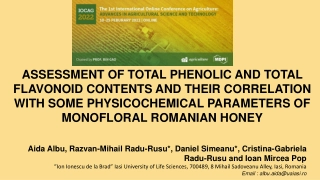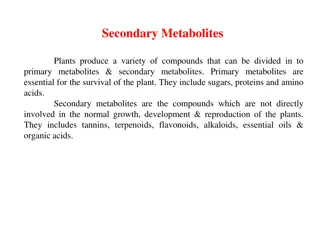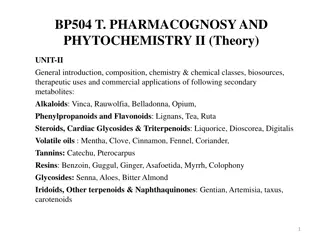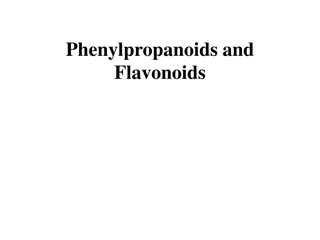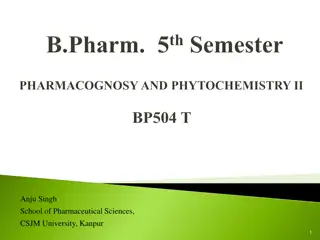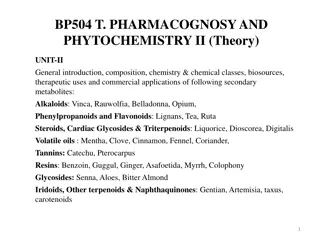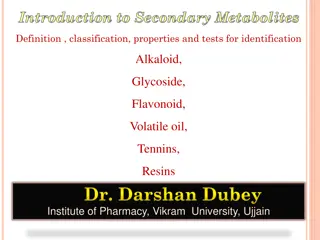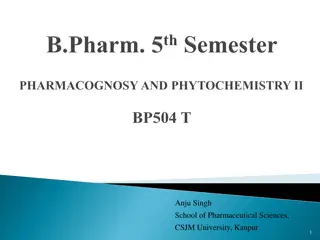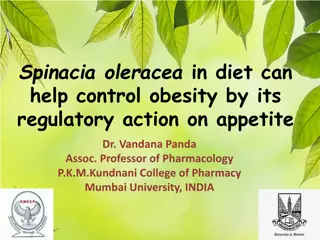Assessment of Total Phenolic and Total Flavonoid Contents in Romanian Monofloral Honey
Honey has been revered for its medicinal properties since ancient times, attributed to its antioxidant qualities. This study examined the total phenolic and flavonoid contents in various mono-floral honey samples from Romania and their correlations with different physicochemical parameters. The find
1 views • 15 slides
Aldol Condensation Reaction: Preparation of Chalcones
Chalcones are important unsaturated aromatic ketones that serve as biogenetic precursors of flavonoids and isoflavonoids. They have various medicinal and pharmaceutical applications due to their biological activities. Chalcones are easily synthesized compounds with potential therapeutic uses, making
2 views • 13 slides
Understanding Plant Metabolites: Primary vs. Secondary & Their Biological Functions
Primary metabolites are crucial for plant survival, including sugars and amino acids, while secondary metabolites, like tannins, terpenoids, and flavonoids, play diverse roles such as protection from pathogens, pigmentation, and health benefits. Tannins offer antiviral and antibacterial effects, ter
1 views • 7 slides
Understanding Secondary Metabolites of Rue (Ruta graveolens)
Rue (Ruta graveolens) is a herb known for its medicinal properties and aromatic leaves. It contains various chemical constituents such as flavonoids, alkaloids, fixed oils, and volatile oils. The herb has a long history of traditional uses, including as an insect repellent and a condiment. Chemical
0 views • 10 slides
Understanding Phenylpropanoids and Flavonoids in Plant Biochemistry
Phenylpropanoids and flavonoids are essential organic compounds synthesized by plants from amino acids like phenylalanine and tyrosine. They play a crucial role in the biosynthesis of various natural products, including lignols, flavonoids, coumarins, and more. The classification of phenylpropanoids
4 views • 15 slides
Overview of Secondary Metabolites: Alkaloids, Flavonoids, Steroids, and Glycosides
Exploring the diverse world of secondary metabolites, this content delves into the composition, chemistry, biosources, therapeutic uses, and commercial applications of various compounds such as Alkaloids, Flavonoids, Steroids, Glycosides, and more. It discusses the structural characteristics, biolog
0 views • 17 slides
Overview of Indole Alkaloids in Pharmacognosy and Phytochemistry II
Indole alkaloids are a significant group of naturally occurring compounds with diverse chemical structures and physiological actions. This unit delves into the general introduction, composition, chemistry, biosources, therapeutic uses, and commercial applications of various secondary metabolites, in
0 views • 17 slides
Overview of Secondary Metabolites: Alkaloids, Glycosides, Flavonoids, and More
Secondary metabolites are chemical compounds produced by plants that have various biological effects. Alkaloids, a type of secondary metabolite, are organic compounds with nitrogen atoms and specific physiological actions. They exhibit diverse physical and chemical properties, making them essential
0 views • 63 slides
Exploring Secondary Metabolites in Ruta Graveolens for Therapeutic Applications
Delve into the world of secondary metabolites found in Ruta graveolens, commonly known as Rue or Garden Rue. Discover its rich composition of alkaloids, phenylpropanoids, flavonoids, steroids, cardiac glycosides, triterpenoids, volatile oils, tannins, resins, glycosides, iridoids, and other terpenoi
0 views • 13 slides
Protective Health Benefits of Tea: A Comprehensive Overview
Tea, especially green tea, offers a range of protective health benefits due to its rich content of flavonoids, catechins, and polyphenols. These compounds act as powerful antioxidants, reducing the risk of heart disease, cancer, diabetes, and other ailments. Tea consumption is linked to improved kid
0 views • 27 slides
Understanding Chemotaxonomy: Classification of Plants Based on Chemical Constituents
Chemotaxonomy, presented by Dr. R. P. Patil, explores the scientific investigation of the chemical characters in plants for taxonomy and phylogeny studies. It involves classifying plants based on their chemical constituents and molecular characteristics. Principles, methods, and importance of chemot
0 views • 24 slides
Spinach in Diet for Obesity Control: Regulatory Action on Appetite
Spinach, scientifically known as Spinacia oleracea, has been highlighted as a beneficial addition to diets aimed at controlling obesity due to its regulatory effect on appetite. Dr. Vandana Panda, an Associate Professor of Pharmacology at P.K.M Kundnani College of Pharmacy, Mumbai University in Indi
0 views • 29 slides
